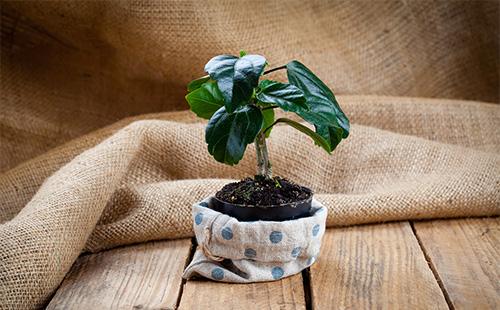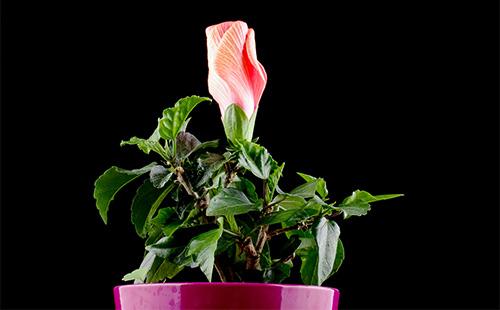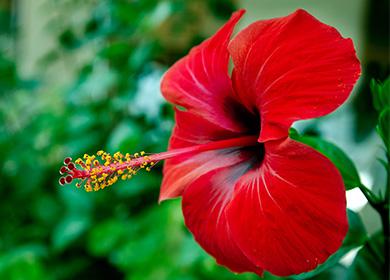The content of the article
Hibiscus is considered a fairly unpretentious plant. It neutralizes the level of illumination, the regularity of irrigation, temperature extremes. Therefore, it can be recommended to beginner gardeners as one of the most beautiful and uncomplicated in growing crops.
What does it look like
Hibiscus is not only common in Asia Minor. It is often found in America, Africa. In wet meadows in floodplains, it forms dense thickets richly decorated with flowers. He loves water very much, for which he received the name “marsh mallow” in his homeland. In our country, hibiscus is often called the Chinese rose.
Hibiscus belongs to the large genus of the family malvaceae. Information on the genus abundance in the sources diverges. On average, the genus has from 150 to 300 representatives. There are wild and cultivated species, different in type of growth and color. The genus includes grassy annuals and perennials, shrubs and trees.
Hibiscus leaves are petiolate with notched edges. Almost all species bloom in large beautiful flowers. The flowers are very elegant, characterized by a bright color of the corolla. After flowering, the fruit ripens - a box with an abundance of seeds. After ripening, the fruit breaks up into five wings.
Indoor Varieties
For home gardening, mostly undersized species are used. Not so long ago, only one species of hibiscus with red double flowers was known in indoor floriculture. Now there is much more choice - new species have been introduced, hybrid varieties with different colors have been bred.
- Chinese hibiscus. An adult plant does not exceed two meters in height. Easily tolerates pruning - you can form a more compact plant. It grows rapidly in width - suitable only for spacious rooms.
- Hibiscus dissected. This variety was brought to us from Brazil. Differs in original flowers of the refined form. The tubular cup is divided into petals. Petals strongly dissected, bend back. The color is red and orange. Pestle protrudes strongly forward.
- Hibiscus Mix. Refers to evergreen shrubs. In good conditions, grows just above a meter. The flowers are large, double or simple. The color is varied. There are varieties with white and deep red flowers. Wide gamma of intermediate shades.
- Hibiscus Cooper. Differently called variegated. The main feature of the variety is unusually colored leaves. Variegated leaves harmoniously combine green, white and red.The flowers are large, but ordinary - pink or red.
What to do after purchase
Bringing the hibiscus home, carefully examine it - the stems, leaves from the outside and inside. Look for pests, signs of disease. Carefully remove it from the pot and inspect the root system for rot and root worm. Hibiscus is usually sold in plastic pots, easily removed and returned to the place.
If you notice something suspicious - dots, spots, gnaws, cobwebs, uneven yellowing of the leaves, treat with special drugs as a preventive measure. Insecticides from pests, fungicides from fungi and diseases.
Whether a hibiscus transplant is needed after purchase is a moot point. Almost all hibiscus trees come to us from Holland. Manufacturers adjust them to the necessary parameters - abundant flowering, leaves of saturated green color, the root system completely braids the earthen lump. Plants are planted in peat with a very high content of fertilizers and growth stimulants. If you sharply move the flower to a less nutrient medium, it can simply die.
If you decide to transplant hibiscus immediately after purchase, then only by transshipment with the complete preservation of an earthen coma. But it is better to wait until the flowering ends. During this time, most of the supply of nutrients is depleted and the flower will transfer the transplant much more calmly. Before transplanting, completely dry the root system, carefully, with a skewer, untangle the roots, clean them from the remnants of the old soil. You do not need to rinse the roots - hibiscus painfully refers to this procedure.
On the second day after planting, you can pour the drug "Zircon". Sometimes hibiscus reacts to stress with lethargy of leaves. Try to put a transparent plastic bag on the plant and inflate it so that the leaves do not touch the film. When the turgor of leaves is restored, the package can be removed. One month after planting, cut the branches as low as possible - this stimulates lateral branching.
Hibiscus Care Features
How to care for hibiscus indoor? It is a fast growing, relatively hardy plant. With good care, it blooms stably and plentifully, reaches large sizes. The rules for caring for hibiscus are quite simple.
- Lighting. The plant is very photophilous - young plants are placed on the windowsill from the east or west. Adults are placed next to the window. On the north side it stretches, fades, ceases to bloom.
- Temperature. He does not like extreme heat. It is advisable to create conditions of comfortable, moderate temperatures of about 20-22 ° C. In winter, rest in the cool is obligatory - 14-16 ° С. Hibiscus can do without a dormant period, but flowering will be sparse.
- Watering. Moisture-loving plant. In the summer they water abundantly, but do not flood it - they allow the top layer of the earth to dry. During watering, make sure that the earthen lump is saturated completely. Excess fluid from the pan is poured 10-20 minutes after watering. In autumn, the frequency of watering begins to gradually decrease - after drying up the soil surface, they wait two to three days. In winter, the intervals between irrigation depend on the temperature of the content. The colder the room, the less often you need to water the hibiscus.
- Humidity. Requires high humidity. Spraying is a mandatory procedure. During flowering, they are sprayed gently, try to avoid getting moisture on the flowers and buds.The problem of dry air is solved using special humidifiers, installing the pot in a tray with a moist filler, spraying air around the plant.
- The soil. It is recommended to use neutral, light and nutritious soil. The optimal composition is sheet soil, humus, turf and sand. Use mixtures without adding peat. A useful additive is charcoal. From ready-made shop soils, you can choose a mixture for citrus crops.
- Top dressing. Fertilizers are applied regularly, but in moderation. In the spring, it is recommended to feed the flower with a drug with a high content of phosphorus and potassium. The rest of the time they use a balanced mineral complex for flowering crops. For example, Kemira Suite. The nitrogen content in any product should be minimal.
- Transfer. Up to three, four years of age, hibiscus is transplanted annually. As growth slows, the intervals between transplants increase to two to three years.
If it does not bloom ...
If hibiscus has stopped blooming, you just need to analyze the conditions of detention. It does not bloom for various reasons - warm wintering, improper watering, too large a pot, lack or excess of trace elements. To stimulate flowering, try the following algorithm:
- In October, cut off all the old shoots, leaving only three eyes on each. If the pot is too large - transplant into a smaller container.
- With the onset of winter, arrange a flower during the rest period at low temperatures of about 15-16 ° C. Limit lighting; water only as needed to maintain light soil moisture.
- At the very beginning of March, a little bit of watering. Dry the ground well.
- Return the pot with the plant to a warm, well-lit place. Spend the first dressing.
- When it gets warmer outside, remove three centimeters of soil and replace it with a new one. The optimal composition is garden soil, dry algae and well-rotted compost.

How hibiscus breeds
Hibiscus can be propagated by seeds or cuttings. Cuttings are a simpler and faster method. Seedlings grow slowly, do not always retain maternal traits.
Seed cultivation
Growing hibiscus from seeds at home is a troublesome and difficult task. Seeds can be collected from your plant or bought at a store. For healthy seedlings, follow these steps.
- Prepare light soil - a mixture of sand and peat. Fill her flat container.
- Moisten the surface of the soil with a spray bottle, cover the container with glass. Glass can be replaced with ordinary polyethylene or cling film. Place a container under the fluorescent lamp, maintain the temperature at 25 ° C.
- After the appearance of the third true leaflet, seedlings can be peaked in separate containers.
Hibiscus from seeds blooms at the earliest in a year, often in two. It completely depends on the quality of care and conditions of detention.
Cuttings
Propagation of hibiscus by cuttings is an easier and faster way. Apical cuttings quickly take root and grow.For successful rooting, adhere to the following scheme.
- Cut apical cuttings 5–8 cm long.
- Treat the slices with a rooting agent solution - “Kornevin”, “Heteroauxin”.
- Prepare a light peat-sand mixture, fill it with small pots.
- Set the handle in the center, cover the pot with a glass jar or a plastic cup. Ventilate daily, monitor soil moisture.
Shelter is removed only after the appearance of persistent signs of growth. To root the hibiscus from the stem for a short time - the roots appear within about a month, after another three to four months the first flowers bloom on the young plant.
Main problems
Quite often you have to deal with yellowing, drying out leaves, falling buds. There are other problems. The reason is not necessarily hidden in the attack of pests or a specific disease - problems can be caused by elementary errors of care. You can get acquainted with the main problems and their causes in the table.
Table - Difficulties in growing hibiscus
| A problem | Possible reasons |
|---|---|
| Leaves turn yellow | - Diseases of the roots; - pests; - leaf chlorosis; - dry air |
| Leaves turn yellow and fall | - Too damp soil in the winter; - low humidity; - stressful situations; - pests |
| Hibiscus drops leaves | - dry air; - stressful situations; - lack of spraying |
| Leaf tips fade | - lack of nutrients |
| Leaves curl | - Aphids or other pests |
| Hibiscus fades completely | - heat; - dry air; - complete drying of the soil |
| Buds fall | - lack of potassium; - heat; - gall midge |

Typical pests
Pest attacks cannot always be avoided. Weakened, diseased plants are more susceptible to insect attacks. The discrepancy between the parameters of the conditions of detention affects the requirements - too dry air, irregular or excessive irrigation. Typical hibiscus pests and ways to control them are given in the table.
Table - Hibiscus Pests
| Insect | Signs | Wrestling |
|---|---|---|
| Aphid | - Stickiness of leaves and buds; - twisting the tops of hibiscus shoots, young leaves; - numerous colonies of small green insects | - If single insects are found, they are washed with soapy water; - when large colonies are formed, the affected shoots are cut off, sprayed with Fitoverm or tobacco dust infusion |
| Spider mite | - In the early stages - yellow dots; - on subsequent - large areas of dried tissue; - a shell of thin spider webs on the back of the sheet | - Increase humidity; - washed with soapy water; - sprayed with means "Akarin", "Lightning" |
| Whitefly | - stickiness of leaves; - yellowing of the leaves; - small white moths on a plant | - Hang sticky traps on adult insects; - sprayed with means of "Bison", "Iskra", "Aktara" - washed with potassium soap |
| Worms | - Whitish waxy discharge on petioles and veins; - wither hibiscus | - The affected parts of the plant are wiped with mineral oil |
| Shields | - Brownish, golden brown plaques | - Mechanically remove pests with a toothbrush; - wipe the affected area with a cotton swab moistened with alcohol or kerosene; - treated with insecticides |
| Gallitsa | - yellowing of the leaves; - the buds do not open, fall off; - midge laying eggs inside the buds | - Remove affected buds - treat the soil with insecticides |
Possible diseases
It is not always possible to avoid infection with viral or fungal diseases. Infection occurs through insect vectors, contaminated soil, from other plants. Diagnose the disease by a number of signs. All signs, names of diseases and their treatment are briefly described in the table.
Table - Hibiscus Diseases
| Disease | Symptoms | Treatment methods |
|---|---|---|
| Hibiscus leaf bronze (virus) | - Yellow spots and small tears on the hibiscus foliage; - coarsening and wrinkling of leaves | - Sick plants destroy; - they will try to isolate hibiscus and treat it with fungicides several times |
| Hibiscus ring spotting (virus) | - Ring-shaped yellowish spots on the leaves | - Cuttings are cut from healthy branches; - the mother plant is destroyed |
| Brown rot of hibiscus (affects only young plants) | - Drilling and thinning of the base of the hibiscus stalk; - falling of leaves; - filamentous mycelium in the soil | - Preventively seedlings and cuttings are sprayed with Rovral |
| Bacterial spotting | - Rotten yellow spots with an oily border | - Treated with fungicides "Euparen", "Fundazol" |
| Tracheomycotic wilt (fungus) | - Dry the tips of hibiscus shoots; - gradually the fungus covers the entire plant; - hibiscus dies | - Cut diseased branches to healthy tissue; - repeatedly treated with fungicides |
Properly organized care for hibiscus (Chinese rose) in a pot will help to avoid most problems. Hibiscus is a long-lived plant. With good care, it can grow and bloom regularly for more than 20 years. Fits perfectly into the interior of spacious rooms.

